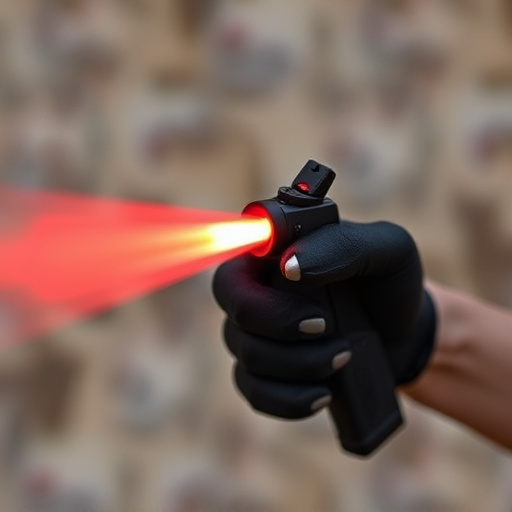Military-grade pepper spray formulas, leveraging capsaicin from chili peppers, serve as powerful non-lethal crowd control tools for law enforcement. With advancements in active ingredients and delivery systems, these sprays enhance effectiveness while prioritizing user and bystander safety during public protests and high-risk security operations. Despite debates on civil liberties versus public safety, their precise targeting capabilities remain crucial for managing large gatherings and disrupting crowds swiftly, balancing the need for rapid intervention with ethical considerations.
Police use of pepper spray as a crowd control measure has sparked intense debates, especially with the recent surge in social gatherings. This article delves into the world of military-grade pepper spray formulas and their role in maintaining public safety. We explore the powerful yet controversial tools, dissecting their effectiveness in tactical deployments while navigating legal and ethical considerations. Understanding these formulations is key to evaluating their use cases and the ongoing discussions surrounding their application.
- Understanding Pepper Spray: A Crowd Control Weapon
- Military Grade Formulas: Power and Safety Considerations
- Effective Use Cases and Tactical Deployment
- Legal and Ethical Debates Surrounding Pepper Spray Usage
Understanding Pepper Spray: A Crowd Control Weapon
Pepper spray, a potent crowd control tool, has been a staple in law enforcement arsenals for decades. At its core, it’s a military-grade formula designed to temporarily incapacitate individuals by causing a burning sensation and difficulty breathing. The active ingredient, capsaicin, is derived from chili peppers, making it an effective yet non-lethal option for managing large gatherings or agitated crowds.
Unlike traditional spray, pepper spray doesn’t seek to cause permanent harm but rather aims to disrupt and disperse individuals quickly. Military-grade formulations offer increased strength and range, ensuring officers can maintain control at a safe distance. This versatility makes it a go-to choice in various scenarios, from public protests to high-risk security operations, where swift action is crucial for public safety and order maintenance.
Military Grade Formulas: Power and Safety Considerations
Modern crowd control measures often rely on military-grade pepper spray formulas, which have evolved significantly over time. These advanced formulations combine powerful active ingredients with precise delivery systems to ensure effectiveness while mitigating safety risks. The use of military-grade pepper spray allows law enforcement agencies to manage large gatherings and potential civil unrest more effectively than traditional methods.
Safety considerations play a crucial role in the development of these formulas, as they must be handled and deployed responsibly to minimize harm to both individuals and the environment. Rigorous testing and rigorous safety standards ensure that these pepper sprays are designed with careful balance, offering sufficient potency to control crowds while maintaining user safety and minimizing bystander impact.
Effective Use Cases and Tactical Deployment
In various crowd control scenarios, military-grade pepper spray formulas have proven to be an effective tool for law enforcement agencies worldwide. These powerful yet non-lethal agents are designed to quickly disrupt and disperse crowds, providing officers with valuable time to reestablish order. The tactical deployment of such sprays involves careful consideration of factors like wind direction, crowd density, and environmental conditions to ensure maximum effectiveness and minimal impact on bystanders.
The unique properties of military-grade pepper spray allow for precise targeting, enabling officers to control chaotic situations without causing permanent harm. This strategic use has been particularly successful in managing large gatherings, protests, or emergency situations where rapid intervention is crucial. By utilizing advanced formulations, law enforcement can navigate challenging crowd control scenarios with efficiency and safety.
Legal and Ethical Debates Surrounding Pepper Spray Usage
The use of pepper spray as a crowd control measure has sparked intense legal and ethical debates. Advocates argue that it’s an effective way to de-escalate potentially dangerous situations, providing a non-lethal force option for law enforcement. However, critics highlight concerns about its potential for overuse, misuse, and negative impact on individuals with respiratory conditions or other health issues. The debate intensifies when considering military-grade pepper spray formulas, known for their high potency, which raises questions about proportionality and the need for such powerful force in civilian contexts.
Ethical considerations also center around transparency and accountability. There’s growing pressure for clearer guidelines and oversight to regulate the use of pepper spray, especially with concerns about its impact on communities of color and individuals with pre-existing medical conditions. Balancing public safety and civil liberties remains a delicate task, as the legal and ethical debates continue to evolve in response to changing societal norms and evolving law enforcement tactics.
Pepper spray, particularly military-grade formulas, serves as a powerful tool in crowd control, but its usage is not without controversy. While effective in de-escalating situations and maintaining public safety, the ethical and legal debates surrounding its application must be carefully navigated. Understanding the nuances of these issues ensures that law enforcement agencies use pepper spray responsibly, balancing public order with individual rights. The ongoing dialogue regarding military-grade pepper spray formulas highlights the need for continuous evaluation and improvement in crowd control tactics to achieve optimal results while mitigating potential risks.
